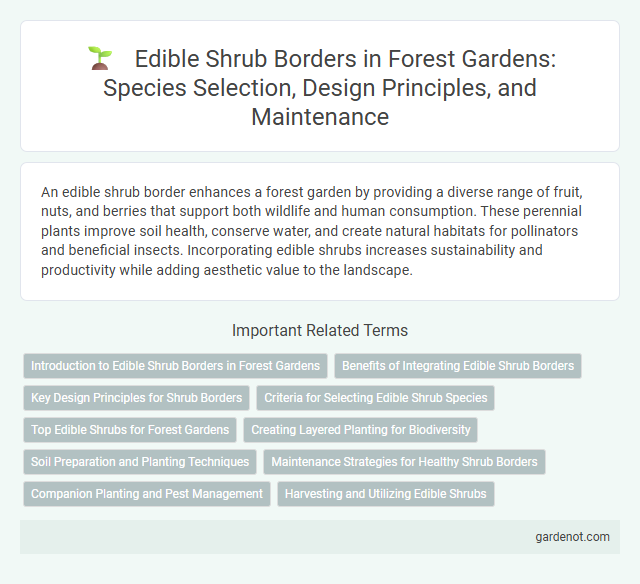An edible shrub border enhances a forest garden by providing a diverse range of fruit, nuts, and berries that support both wildlife and human consumption. These perennial plants improve soil health, conserve water, and create natural habitats for pollinators and beneficial insects. Incorporating edible shrubs increases sustainability and productivity while adding aesthetic value to the landscape.
Introduction to Edible Shrub Borders in Forest Gardens
Edible shrub borders in forest gardens create layered, productive edges combining fruiting and nut-bearing shrubs like hazelnut, currant, and elderberry. These shrubs enhance biodiversity, provide habitat for beneficial insects, and support soil health through nitrogen fixation and organic matter accumulation. Integrating edible shrub borders maximizes space efficiency while offering sustainable yields of nutritious produce year-round.
Benefits of Integrating Edible Shrub Borders
Integrating edible shrub borders in forest gardens enhances biodiversity by attracting pollinators and beneficial insects crucial for ecosystem health. These shrubs provide a sustainable source of nutrient-rich fruits, nuts, and berries, supporting food security while reducing reliance on external inputs. Edible shrub borders also improve soil quality through nitrogen fixation and organic matter contribution, fostering a resilient and productive garden system.
Key Design Principles for Shrub Borders
Edible shrub borders in forest gardens maximize layered productivity by combining fruiting shrubs with complementary plants that enhance biodiversity and soil health. Key design principles include selecting diverse species with staggered harvest times, ensuring sunlight access for fruiting shrubs, and incorporating nitrogen-fixing plants to improve fertility. Strategic spacing allows air circulation and pest control, while mulch and ground cover minimize weed competition and retain moisture.
Criteria for Selecting Edible Shrub Species
Selecting edible shrub species for a forest garden border involves prioritizing plants with high nutritional value, adaptability to local soil and climate conditions, and compatibility with surrounding flora. Species chosen should offer disease resistance, seasonal yield diversity, and support for local pollinators to enhance ecosystem health. Emphasizing native or well-adapted shrubs like currants, elderberries, and goji berries ensures sustainability and continuous harvest potential.
Top Edible Shrubs for Forest Gardens
Top edible shrubs for forest gardens include species such as blueberry (Vaccinium corymbosum), elderberry (Sambucus nigra), and currants (Ribes spp.), which provide nutrient-rich fruits and support biodiversity. These shrubs thrive in partial shade and improve soil health through nitrogen fixation or deep root systems, enhancing overall garden productivity. Incorporating diverse edible shrubs creates a sustainable, multi-layered ecosystem that maximizes yield and attracts beneficial wildlife.
Creating Layered Planting for Biodiversity
An edible shrub border in a forest garden enhances biodiversity by incorporating multiple planting layers such as ground covers, understory shrubs, and canopy trees. This stratified approach maximizes habitat complexity, supports pollinators, and encourages beneficial insects. Selecting native and fruit-bearing shrubs like elderberry, currant, and hazelnut promotes year-round food production while sustaining local wildlife.
Soil Preparation and Planting Techniques
Edible shrub borders thrive in well-drained, nutrient-rich soil amended with organic compost and mulch to enhance soil structure and moisture retention. Proper soil preparation involves double digging and incorporating slow-release fertilizers to support root development and long-term growth. Planting techniques include spacing shrubs according to mature size, planting at root flare level, and applying a thick mulch layer to suppress weeds and conserve moisture.
Maintenance Strategies for Healthy Shrub Borders
Regular pruning and mulching are essential maintenance strategies for healthy edible shrub borders, as they promote vigorous growth and suppress weeds. Monitoring soil moisture and fertility ensures optimal nutrient availability, supporting robust fruit production and plant resilience. Integrating companion plants helps deter pests naturally, reducing the need for chemical interventions.
Companion Planting and Pest Management
Edible shrub borders in forest gardens enhance biodiversity and improve pest management through strategic companion planting, promoting natural pest control by attracting beneficial insects and repelling harmful pests. Integrating diverse species such as currants, gooseberries, and elderberries creates microhabitats that support predatory insects and pollinators, increasing overall garden resilience. This layered planting approach reduces reliance on chemical interventions, fostering sustainable pest management and boosting productivity.
Harvesting and Utilizing Edible Shrubs
Edible shrub borders in a forest garden yield nutrient-rich fruits, berries, and leaves, ideal for fresh eating or preservation through drying and freezing. Regular harvesting during peak ripeness maximizes flavor and nutritional content while promoting healthy plant growth and increased yields. Utilizing these shrubs supports sustainable food production, enhances biodiversity, and diversifies seasonal foraging options.
Edible shrub border Infographic

 gardenot.com
gardenot.com